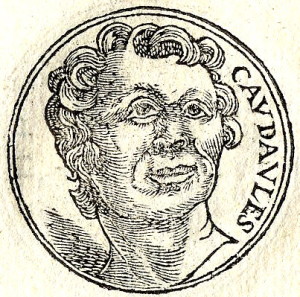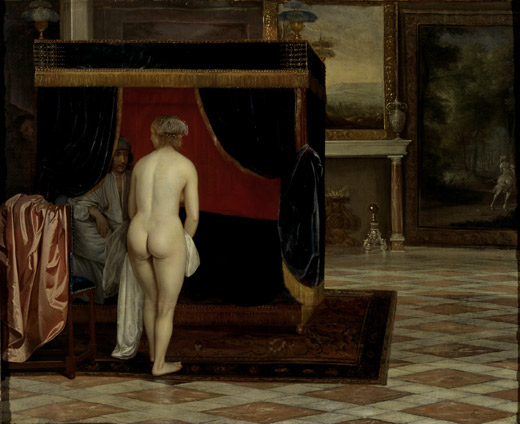
A 16th century portrait of King Candaules of Lydia, who reigned from 735 BC to 718 BC according to tradition, from Guillaume Rouillé’s iconography book entitled Promptuarii Iconum Insigniorum.
Let it be known to all the swingers out there: King Candaules was no Candaulist. My swinger friends, read on.
Imagine you are the queen of Lydia. It is late and you are about to disrobe before your king in the privacy of his royal bedchamber. The monarch is reposing on a sumptuous bed that is perfumed with myrrh, aloes, and cinnamon. His eyes keep fixated on you as you move toward a chair situated near the doorway of the room. You stand motionless for a time, as is your custom, soaking in your exquisite surroundings through the flickering candlelight. He clutches giddily at a plush cushion with trembling hands. It is time. You pull the ivory pin fastening your hair, shake out your dark-brown curls, and proceed to slip out from your finely embroidered robe and place it on the chair. In captivating fashion you let drop your undergarments one after another around you. There you stand before your adoring husband with your youthful form revealed in all its beauty. But just then, all of a sudden, a strange sense of being watched creeps over you. You cast a furtive glance toward the doorway, instantly recognising the voyeur peering back at you from the shadows. The interloper gasps. A panicky utterance from the king cannot mask the ensuing patter of feet followed by an awful clatter down the stairs. As a succession of muted groans reverberate into the night, you are faced with the infuriating realisation that the king was behind the entire plot. In the awkward silence that follows you a) confront the king, b) cover yourself and scream for the royal guards, or c) say it was probably just the cat and handle it in the morning.
If your name is Queen Nyssia, the voyeur is Gyges, and Candaules is king, then you will choose option (c) and handle it in the morning. This at any rate is the story as it is related by Herodotus. That is apart from Gyges toppling headlong down the royal staircase, which is an elaboration on the series of events of my own invention (see Footnote 1). Herodotus, in any case, writes in some detail on Candaules’ efforts to persuade Gyges to view his wife [1]:
This Candaules, then, fell in love with his own wife, so much so that he believed her to be by far the most beautiful woman in the world; and believing this, he praised her beauty beyond measure to Gyges son of Dascylus, who was his favorite among his bodyguard; for it was to Gyges that he entrusted all his most important secrets. After a little while, Candaules, doomed to misfortune, spoke to Gyges thus: “Gyges, I do not think that you believe what I say about the beauty of my wife; men trust their ears less than their eyes: so you must see her naked.”
Gyges made every attempt to turn down Candaules’ request, but in the end the king’s will prevailed, and he consented to the proposal. Nyssia, having surmised all of this, sent for Gyges at dawn the next morning and presented him with a choice: either commit suicide at once as retribution for his transgression or murder Candaules and usurp the throne with her as his wife. Gyges pleaded with Nyssia to reconsider, but he soon found this to be a hopeless cause, and reluctantly agreed to kill his master. They murdered Candaules in his bed on the very next night.

The wife of Candaules discovers the hidden Gyges by Dutch painter Eglon Hendrik van der Neer around 1675–80.
After being named king, Gyges legitimised his hold on power, which was still precarious, by securing a favourable declaration from a Delphic oracle. The oracle coupled a confirmation of Gyges’ right to rule over the Lydians with a prophesy that Candaules’ family – the Heraclids – would take revenge on the usurper in the fifth generation. The prophecy proved true, but by that time Gyges was dead. In recognition of the oracular endorsement, Gyges had a hoard of gold and silver sent to the shrine at Delphi. The delivery included, we are told, six golden mixing-bowls that weighed nearly 800kg when taken all together (see Footnote 2). Gyges reigned for a total of 38 years (from 716 BC to 678 BC according to tradition) and was succeeded by his son Ardys II. No further details on the life of Nyssia are recorded.
This is the Herodotean narrative of Gyges’ rise to power. Modern scholarly opinion has Herodotus drawing on dramatic rather than historical sources, and it has been speculated that his story is based on a tragedy in five acts with three actors and a chorus [3]. Many alternative versions of the story circulated in antiquity. The most curious among them is presented as a thought-experiment of sorts in Book II of Plato’s Republic [4]. In this telling, Gyges is made to be a common shepherd who discovers a ring of invisibility while out pasturing his flocks. With the fear of being apprehended and punished for immoral behaviour removed, the once loyal subject, conspires with Nyssia to murder Candaules and takes the throne for himself. Various oddities surrounding the discovery of the ring that I have omitted are summarised by James Adam [5]; for the other versions of the story see Wikipedia [6].
As for Candaules, his legacy is wrongly coloured by an association with the eponymous sexual practice of Candaulism. The term was coined by the 19th century psychiatrist Richard von Krafft-Ebing to describe the practice in which a man reveals his female partner, or images of her, to others for their voyeuristic delight. While this certainly applies to the fictional Candaules, there is no reason to suppose that it is also true of the historical one. The historical Candaules, supposing he even existed, was probably overthrown and murdered by Gyges. Any speculation beyond that is liable to enter into the realm of fantasy.
The distinction between the fictional and historical Candaules is clear among classicists and Wikipedians alike, but the same cannot be said for the swinger community. Indeed, a quick perusal of swinger websites and message boards reveals that this distinction is not clear. In all fairness, they can hardly be blamed for being ignorant of the etymological subtleties surrounding a term that was introduced as a label for a largely obscure swinger pastime. My objective is not to assign blame, but rather to set the record on Candaules straight for the swinger subculture.
There is no shortage of choices should the Candaulists among us wish to rename their hobby after a more appropriate individual. Known or suspected Candaulists down the ages include:
- Louis I of Orléans: Painted by Eugène Delacroix unveiling his mistress, Mariette d’Enghien, before an unnamed onlooker [7].
- Sir Richard Worsley: Assisted George Bissett to spy on Lady Worsley taking a bath [8].
- Salvador Dali: Displayed his wife, Gala, to other men according to biographers [9].
- Robert Hanssen: Invited a friend to secretly observe him making love to his wife. He later set up a closed-circuit television to allow the friend to watch from another room [10].
It will be admitted, however, that none of these men quite measure up to Candaules in terms of glamour and intrigue with the possible exception of Dali. Also Candaulism does have a nice ring to it. And in any case, bringing about a change in the usage of a term with a century old precedent, like Candualism, is bound to end in failure. In the end the only realistic alternative is to accept Candaulism as a term and concentrate on raising awareness in swinger circles that the historical Candaules was no Candaulist.
Footnotes
[1] It will also be noted that Herodotus does not refer to the queen by name. The Greek grammarian Ptolemaeus Chennus, writing in the 2nd century AD, names the queen as Nyssia [2]. He adds that she is called Tudun, Clytia, and Habro in other sources. We are told, moreover, that Nyssia had double pupils and it was owing to this peculiar abnormality that she was able to glimpse Gyges standing in the doorway. In some versions of the story, her double pupils were caused by exposure to a serpent stone of some kind. The reason why Herodotus neglected to mention her name is also revealed. According to Chennus, Herodotus was taken in with a youth called Plesirrhous, who spurned the father of history so that he might pursue a Halicarnassian woman with the same name as the queen. Plesirrhous proved unsuccessful in his efforts to woo this Nyssia and hanged himself. Herodotus was presumably left bitter by the association.
[2] No trace of these mixing-bowls have ever been found.
References
[1] The Histories by Herodotus; translated by A. D. Godley (1920), Harvard University Press, Book I, Chapters 8-13. Read Herodotus’ passage about Candaules at The Perseus Project.
[2] Bibliotheca (Codex 190) by Photius; translated by Roger Pearse from a French translation by René Henry (1977). Codex 190 is a synopsis of a lost book thought to have been written by the Greek grammarian Ptolemaeus Chennus in the 2nd century AD, although Photius attributed the work to an obscure figure by the name of Ptolemy Hephaestion. Read the passage on Queen Nyssia at the The Tertullian Project (search on “Nysia”, not “Nyssia”).
[3] A Commentary on Herodotus Books I-IV by David Asheri et al. (2007), Oxford University Press, Page 81. Preview this commentary on the story of Candaules at Amazon.com.
[4] The Republic of Plato translated by James Adam (1902), Cambridge University Press. Read Plato’s mythological telling of the Gyges story at The Perseus Project.
[5] Gyges by Harry Thurston Peck in Harpers Dictionary of Classical Antiquities (1898), Harper and Brothers. Read this encyclopedia entry on Gyges at The Perseus Project.
[6] “Gyges of Lydia” page on Wikipedia.
[7] The Duke of Orléans showing his Lover by Eugène Delacroix (circa 1825-26). View this painting at The Web Gallery of Art.
[8] Lady Worsley’s Whim: The divorce that Scandalised Georgian England by Hallie Rubenhold (2008), Vintage Books.
[9] Before Photoshop Was Invented, There Was Dali; in the Latest in His Series on Striking Images, Our Columnist Looks at the Surreal Mind of an Artist and How Dreams Have Inspired Him and Others, London Evening Standard – August 21, 2014. Preview this article at Questia.
[10] Spy: The Inside Story of How the FBI’s Robert Hanssen Betrayed America by David Wise (2003), Random House Trade Paperbacks.


